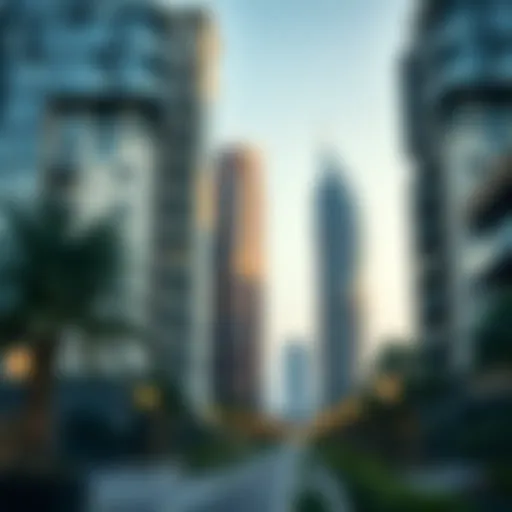Cloud Towers: Transforming Dubai's Real Estate Scene


Intro
Dubai's skyline is frequently cited as a marvel of modern architecture, primarily shaped by the emergence of innovative structures known as cloud towers. These skyscrapers represent not only a physical aspect of the city but also embody the aspirations of a society driven by technological advancement and aesthetic ambition. Amidst the sprawling urban landscape, cloud towers stand out—with their visually striking designs and environmental considerations highlighting a new era in architecture.
Cloud towers are not merely tall buildings; they integrate cutting-edge technology and sustainable practices, positioning themselves at the forefront of Dubai's real estate scene. However, understanding their implications, both architecturally and economically, requires a deeper analysis of current market trends and investment opportunities.
In the following sections, we will dissect how these towering structures influence the market dynamics, shifting property price trends, and the potential for smart investment. As we explore these elements, a clearer picture of the role cloud towers play in shaping the future of Dubai's real estate will emerge.
Prologue to Cloud Towers
The rise of cloud towers in Dubai represents a fascinating chapter in the narrative of modern architecture and urban living. These innovative structures are not merely skyscrapers; they embody the sheer ambition and vision of a city keen on pushing the envelope of what urban spaces can achieve. In this article, we delve into the various aspects surrounding the concept of cloud towers, illuminating their significance in Dubai’s real estate landscape.
Cloud towers serve as a testament to Dubai’s relentless pursuit of excellence and its adaptability in a rapidly changing global market. From their breathtaking designs that allure investors and tourists alike to their potential impact on property values and urban dynamics, exploring these towers unveils intricate layers of economic, social, and technological dimensions.
Defining Cloud Towers
Cloud towers can be defined as high-rise buildings that extend above the traditional skyline, often designed with unique aesthetics and sustainability features. They stand out for their cloud-like formations, which not only create a visual spectacle but also utilize cutting-edge engineering techniques to optimize space and functionality. These buildings are often mixed-use, combining residential, commercial, and recreational spaces to create vibrant urban ecosystems.
When we talk about the characteristics of cloud towers, several elements come into play:
- Height and Design: Generally more than 20 floors, these towers utilize vertical space to the maximum.
- Sustainability: Most cloud towers incorporate energy-efficient technologies and green building materials, aiming for certifications like LEED.
- Smart Features: Integration of technology in building management systems, including IoT capabilities, enhancing the user experience drastically.
Understanding these defintions is crucial for key stakeholders, such as investors and homeowners, who are navigating the complexities of the Dubai real estate market.
Historical Context and Evolution
To appreciate where cloud towers stand today, it is essential to examine their historical journey. The concept began to gain traction in the late 20th century, driven by rapid urbanization and the need for efficient land utilization in cities like Dubai. The initial designs were influenced by the need for vertical living solutions, a reaction to limited land space and booming populations.
As technology progressed, so did the ideas surrounding cloud towers. The first of their kind in Dubai can be traced back to the early 2000s, coinciding with the city’s effort to establish itself as a global hub. The Burj Khalifa, completed in 2010, set a precedent not just for height but for design and functionality, laying the groundwork for subsequent developments.
Over the past couple of decades, architectural firms have embraced new materials and construction techniques that allow for more inventive designs. This interest in sustainable and technologically integrated structures continued through the 2010s, often blending local cultural elements with international building trends. Recent designs have even started to explore more organic structures, aiming to blend with the environment rather than simply dominate it.
Architectural Significance
The architectural significance of cloud towers in Dubai extends far beyond their striking appearances. These structures are emblematic of the city's ambition and vision. They represent a marriage between artistry and innovation, transforming the skyline into something uniquely modern and vibrant. But what makes these towers notable? It's not just about how tall they stand, but about the fresh design philosophies and functional elements that challenge conventional architectural norms.
Design Principles
Design principles for cloud towers often prioritize flexibility and functionality alongside aesthetics. Unlike traditional structures that might focus solely on height and grandeur, cloud towers integrate the concept of livability within verticality. For instance, many buildings emphasize multi-use spaces that allow for residential units, commercial areas, and recreational facilities all in one location. This mixed-use approach brings communities together, fostering interaction and accessibility, which are essential in today’s urban life.
Elements like open floor plans and modular designs are crucial here. They allow for adaptability to meet various needs over time, catering to changing demographics and lifestyles. Additionally, architects draw inspiration from the region's cultural heritage, infusing elements with local significance that resonate with residents and visitors alike, creating a balance between heritage and innovation. The result is not just a tower, but a landmark that tells a story.
Materials and Technology
The materials and technology used in constructing cloud towers are equally significant. With a focus on sustainability and efficiency, these structures employ cutting-edge construction methods and innovative materials. Advances in glass technology, for example, allow for energy-efficient designs that maximize natural light while minimizing heat gain. This is an important consideration in the hot climate of Dubai.
Moreover, composite materials often come into play. These materials provide durability while reducing weight, allowing for higher designs without compromising safety. Furthermore, prefabrication techniques are utilized extensively, which streamline the construction process and reduce waste—an important aspect given the environmental considerations that modern architecture must address.
Another critical factor is the incorporation of smart building technologies. Features such as automated lighting and climate control not only enhance user experience but also contribute to energy conservation. Integrating such technology ensures that cloud towers are prepared for tomorrow's demands, marking them as pioneers in the construction sector.
"In Dubai, cloud towers aren't just structures; they're reflections of visionary urban planning and community-centric design."
By aligning architectural developments with technological advancements and sustainable practices, Dubai's cloud towers stand at the forefront of a new era in real estate. Their architectural significance will undoubtedly reverberate as a model for future constructions, both regionally and globally.
Technological Integration
Technological integration within cloud towers represents a pivotal element driving not only architectural innovation but also enhancing the functionality of living and working spaces. In Dubai, where the skyline is constantly evolving, the embrace of advanced technologies ensures that cloud towers are not just visually stunning, but also smart — in every sense of the word. The amalgamation of technology within these structures contributes significantly to their overall appeal, making them attractive to investors, homeowners, and urban planners alike.
Smart Building Features
Smart building features are at the heart of the technological integration in cloud towers. These sophisticated systems bring a fusion of convenience, efficiency, and sustainability. By equipping buildings with smart sensors, integrated systems, and automated controls, developers can enhance the living experience significantly. For instance, consider the following features:
- Automated Climate Control: Smart thermostats and sensors can automatically adjust heating and cooling based on occupancy and outside weather conditions, maximizing comfort while minimizing energy waste.
- Advanced Security Systems: With features like facial recognition cameras, remote access via mobile apps, and smart locks, residents can enjoy enhanced security that adapts to their needs.
- Real-time Monitoring: Smart buildings can monitor energy usage, water leaks, and air quality in real-time, helping to maintain an environment that promotes well-being.
- Integration with Personal Devices: Homeowners and tenants can control various aspects of their living spaces via mobile applications, providing a seamless experience that aligns with today’s digital lifestyle.
These features make cloud towers not only a place to live or work but a complete lifestyle experience that resonates with the needs of modern urbanites.


Impact of IoT on Cloud Towers
The Internet of Things (IoT) has profoundly affected the operational dynamics of cloud towers. With devices and systems interconnected, the synergy created facilitates vastly improved functionality and user experience. The focus on IoT within cloud towers underscores several benefits:
- Enhanced Energy Management: IoT devices can collect data on energy consumption patterns, enabling more efficient use of resources. This can lead to lower utility costs and reduced environmental impact.
- Predictive Maintenance: By monitoring equipment health through connected sensors, property managers can foresee potential issues before they escalate, saving time and costs in operations.
- User-Centric Experiences: The integration of personalized IoT applications allows residents to tailor their environments—from adjusting lighting and temperature to controlling entertainment systems, making them feel more at home.
- Improved Communication: A connected building fosters better interaction among residents, management, and service providers, creating a community feel even in high-rise environments.
"Technological integration through IoT is not just an addition; it's a statement of the future, hinting at what living and working could be in tomorrow's urban landscapes."
The impact of IoT on cloud towers cannot be overstated; it reshapes how residents interact with their surroundings, offering an investment into future-ready living spaces that align with prevailing global trends focused on efficiency and connectivity.
Overall, the integration of modern technologies in cloud towers in Dubai marks a watershed moment in the evolution of real estate, setting new standards and expectations for what buildings can achieve in the contemporary age.
Sustainability in Cloud Tower Design
Sustainability takes center stage in the design and development of cloud towers in Dubai, reflecting the growing global emphasis on environmentally responsible architecture. This focus on sustainability is not merely a trend; it serves as a critical response to the pressing challenges of urbanization and climate change. As investors and homeowners become increasingly conscious of the ecological footprint their properties create, incorporating sustainable practices becomes not just beneficial but essential.
The landscape of Dubai’s real estate market is significantly influenced by the demand for green building practices. Sustainability in the design of cloud towers encompasses various dimensions, from energy consumption and resource management to the health of occupants. By adhering to sustainable principles, these towers not only contribute to environmental preservation but also promise long-term economic benefits.
Green Building Certifications
Achieving green building certifications is one of the most vital aspects of sustainable design. Not only does it set a benchmark for construction standards, but it also enhances marketability and creates a competitive edge. Certifications like LEED (Leadership in Energy and Environmental Design) and BREEAM (Building Research Establishment Environmental Assessment Method) affirm a tower's commitment to reducing its resource use and impact on the environment.
The process of obtaining these certifications involves rigorous assessments, focusing on several key elements such as:
- Water Efficiency: Optimizing water usage and managing wastewater.
- Energy and Atmosphere: Encouraging energy-efficient designs and renewable energy sources.
- Materials and Resources: Reducing material waste and promoting sustainable sourcing of materials.
- Indoor Environmental Quality: Ensuring a healthy environment for occupants through air quality and natural light.
Staying ahead on such certifications can yield financial benefits in the form of tax incentives and increased property values as the market increasingly favors sustainable developments.
Energy Efficiency Solutions
Implementing energy efficiency solutions is another cornerstone of sustainability in cloud towers. Emphasizing technologies that reduce energy consumption not only drives down operational costs but also supports broader environmental goals.
Among the most effective energy efficiency strategies are:
- Smart Lighting Systems: Utilizing motion sensors and LED technology to minimize energy use while maximizing illumination.
- High-Performance Insulation: Ensuring that buildings maintain temperature control, which lessens the load on HVAC systems.
- Renewable Energy Installations: Utilization of solar panels or wind turbines can significantly offset energy needs, making structures more self-sufficient.
- Building Automation Systems: These systems control heating, lighting, and cooling to optimize energy usage, adapting to real-time conditions and occupancy levels.
Such solutions contribute not only to reducing energy bills but to minimizing harmful emissions. As we forge into the future, the expectation for more efficient buildings will likely shape new projects, thus redefining the standard for what constitutes a modern cloud tower in Dubai.
Integrating sustainability into cloud towers is not just an ethical choice; it can drive significant economic advantages and elevate property appeal in a competitive market.
Economic Implications
The economic dimension of cloud towers in Dubai's real estate landscape is not something to take lightly. These structures are more than just impressive feats of engineering; they are at the heart of Dubai's economic ambitions. In a city known for its rapid growth and continual reinvention, the emergence of cloud towers represents a strategic move toward attracting investments, boosting local economies, and providing a unique opportunity for various stakeholders.
The allure of cloud towers can be tied directly to their investment potential. As prime pieces of real estate, they attract not only homeowners but also investors looking for robust avenues for capital appreciation. When a city embraces modern architectural marvels like cloud towers, it sends a message to the world: "We’re open for business!" This can lead to increased foreign direct investment, which is essential for sustaining economic growth in a globalized market.
Moreover, cloud towers often come equipped with mixed-use functionalities, combining residential, commercial, and hospitality spaces. This blend creates a vibrant ecosystem that can support diverse economic activities. From shops and restaurants that benefit from increased foot traffic to office spaces that draw major companies, the symbiotic relationships fostered within these towers lead to a flourishing local economy.
"The economic impact of cloud towers isn't just about their build costs; it's about the ripple effects that influence local communities and the broader economy."
Investment Potential
Investment potential associated with cloud towers is a value proposition that can't be ignored. The innovation behind these buildings, characterized by sustainable design and advanced technology, makes them particularly appealing to discerning investors. For example, an investor purchasing a unit in one of Dubai's iconic cloud towers can expect not just a place to live but also a potential increase in property value over time due to the unique positioning of the towers in a competitive real estate market.
Key points to consider include:
- Location: Many cloud towers are strategically located in areas prone to development and revitalization, which tends to drive up demand.
- Eco-Friendly Features: As sustainability grows in importance, cloud towers that incorporate green technologies can fetch higher prices and attract tenants willing to pay a premium for environmentally conscious living spaces.
- Market Trends: With increased interest in luxury living and high-tech amenities, properties in cloud towers generally perform well in terms of rental returns and resale value.
Impact on Property Values
The influence of cloud towers on property values in Dubai cannot be overstated. As these structures reshape the skyline, they also alter the perceptions of adjacent neighborhoods. Areas surrounding cloud towers experience a hike in property values due to improved infrastructure, enhanced aesthetics, and overall urban rejuvenation.
Some important aspects include:
- Increased Demand: Properties adjacent to or within cloud towers typically see an uptick in demand, thereby pushing up property prices.
- Market Stability: The presence of such iconic structures tends to stabilize property values, making them a safer bet for investors and homeowners alike.
- Cultural Shifts: The lifestyle offered by living or working in a cloud tower can make these properties desirable for a broader demographic, further driving demand and pricing.


Investors eyeing the Dubai real estate market should keep their fingers on the pulse of the developments around cloud towers. Understanding the economic implications and recognizing the potential new heights these properties can reach is essential for making informed decisions.
Social Dynamics of Cloud Towers
In the ever-evolving landscape of Dubai's real estate, cloud towers are not just remarkable feats of architecture; they play a pivotal role in shaping the social fabric of communities. Understanding the social dynamics within these structures is essential, as it influences everything from community development to cultural integration. This section lays bare the intricate ways in which cloud towers foster social interaction and contribute to the overall progress of urban living.
Community Development
Cloud towers often serve as more than just residential spaces; they act as hubs for community engagement. The inclusion of shared amenities like parks, gyms, and co-working spaces not only enhances the quality of life but also encourages residents to interact with one another. For instance, in the iconic Burj Khalifa, residents benefit from communal lounges and event spaces, promoting a sense of belonging and camaraderie.
Furthermore, with the rise of mixed-use developments, cloud towers provide a melting pot for diverse populations. This blend of cultures fosters inclusivity and creates opportunities for cross-cultural dialogues. The Dubai Marina Towers, for example, attract a global community, leading to a vibrant neighborhood where ideas and traditions mingle freely.
Building community ties is not just about physical spaces. Developing initiatives like social events, workshops, or interest groups significantly strengthens bonds among residents. Local partnerships with businesses can also lead to neighborhood markets or exhibitions, enhancing the local economy and creating more engagement opportunities.
Cultural Integration
Cultural integration within cloud towers is another significant aspect that cannot be overlooked. These structures reflect the cosmopolitan nature of Dubai itself, as they attract residents from all walks of life. The architectural style often incorporates local traditions blended with modern design, symbolizing the city’s identity.
Moreover, cloud towers are a stage for cultural exchange. Many developments host art shows, cultural festivals, and various community activities that celebrate the rich diversity of their inhabitants. For example, The Address Downtown is known to host events during local cultural festivities, drawing in families and promoting multicultural interaction.
This integration often results in a dynamic cultural tapestry. Residents not only coexist but also actively engage in each other's cultures through shared experiences and collaborative events. By nurturing an environment where different customs and traditions are celebrated, cloud towers reinforce social cohesion.
"Cloud towers are more than mere structures; they embody the spirit of coexistence and innovation that Dubai stands for."
In summary, the social dynamics of cloud towers extend far beyond their impressive façades. They are essential to fostering community spirit and cultural integration, enabling Dubai to thrive as a global city. As the skyline transforms, these towering structures remain central to understanding the varied aspects of life that define urban existence in this vibrant metropolis.
To gain further insights into community dynamics and urban development, you can check resources like Wikipedia or Britannica.
Cloud Towers and Urban Development
Understanding the impact of cloud towers on urban development is crucial, particularly in a city like Dubai where innovation and modernization meet cultural richness. Cloud towers, prominent as architectural beacons, aren't merely buildings; they symbolize a transformation in urban landscapes. Their significance lies in their ability to reshape not just the skyline, but also the socio-economic dynamics of the areas surrounding them.
Transforming the Skyline
The skyline of Dubai has become iconic, characterized by its extraordinary vertical growth. Cloud towers play a pivotal role in this metamorphosis, serving as distinctive landmarks that draw attention and admiration. They often showcase unique architectonic styles, capturing elements from various cultures while embodying cutting-edge design principles.
- Highlights on Visual Appeal: The sheer height of these structures often translates to panoramic views of the city, enhancing their allure.
- Cultural Significance: Each cloud tower contributes to a story, representing a blend of tradition and futuristic ambition.
- Tourism Attraction: Tourists and business travelers are increasingly drawn to places where they can experience world-class amenities, making cloud towers essential in attracting extensive footfall.
In essence, transforming the skyline extends beyond mere aesthetics; it stirs local pride and fosters a global presence, placing Dubai firmly on the map as an international hub.
Influence on Infrastructure Planning
The development of cloud towers incurs varied repercussions on infrastructure planning. As cities like Dubai expand horizontally, incorporating vertical solutions becomes imperative. Proper planning for cloud towers involves recognizing their potential to influence surrounding infrastructure, which in turn supports a cohesive urban environment.
- Traffic Management: The influx of residents and visitors necessitates comprehensive traffic studies to accommodate changes effectively. Data indicates that smart traffic systems need to complement high-density living.
- Essential Services: With more people residing or working in cloud towers, demand for public services, like water and waste management, surges. This requires city planners to innovate solutions ahead of time to ensure seamless living experiences.
- Public Transport Integration: Efficiency in public transportation becomes vital. Towers may ideally serve as hubs or gateways to facilitate easy commuting for both residents and travelers.
As a result, thoughtful urban development that recognizes the implications of cloud towers can lead to more robust infrastructures that provide lasting benefits for residents and businesses alike.
"Cloud towers symbolize not only architectural aspirations but also the future of urban living. They facilitate a transformative journey in urban planning that thrives on innovation and connectivity."
Through a thorough analysis of these elements, it's clear that cloud towers are not just remarkable structures. They are critical components in redefining what urban living means in a rapidly evolving landscape. By being at the forefront of architectural and infrastructural planning, cloud towers embody the future of city construction, meeting economic and social needs.
Challenges in Cloud Tower Development
The journey to establish cloud towers in Dubai is not without its bumps in the road. While these structures symbolize innovation and progress, they also present a fair share of hurdles that must be navigated carefully. Understanding these challenges is critical for anyone involved in the real estate landscape of this vibrant city, from investors and homeowners to agents and analysts.
The sheer scale of these projects means that overlooking any factor can lead to costly delays and unforeseen complications. Therefore, a deep dive into the regulatory environment and technological constraints that these towers face is essential.
Regulatory Hurdles
One of the cornerstone challenges in the development of cloud towers lies in the labyrinth of regulatory requirements. Dubai has established strict building codes and safety standards—these regulations are in place to ensure both structural integrity and public safety. This often translates into a lengthy approval process. Each element, from the building materials used to the height of the structure, must pass rigorous scrutiny. Investors and developers can find themselves bogged down in paperwork and permits, leading to increased costs and extended timelines.
Furthermore, the local government's focus on sustainable building practices introduces an added layer of complexity. Adhering to environmental regulations, for example, is not just a suggestion but a mandate. Developers must navigate through an array of certifications and meet specific sustainability benchmarks. Failing to comply can result in fines or even a halt in construction, making it essential for developers to stay informed and proactive.
In addition to local regulations, global trends in architecture and engineering also affect development standards. Collaborating with international architects or engineers may introduce potential friction due to varying standards and practices. Keeping communication fluid between local and international teams can be quite the tightrope walk.


Technological Limitations
The second major hurdle is rooted in technological limitations. While Dubai is often seen as a beacon of innovation, the reality is that the technology required for such ambitious structures is still evolving. For instance, the smart features integrated into these towers—like climate control systems or automated lighting—must be compatible with various existing infrastructures.
Moreover, the reality is that not all construction firms have access to cutting-edge technology. Small and medium-sized enterprises might find themselves at a disadvantage if they can't afford advanced tools or skilled personnel adept in using them. This can impede the overall pace of development, chaining projects to outdated methods that don't meet modern expectations.
In addition, the reliance on advanced materials can also lead to complications. Some materials touted for their sustainability credentials may not yet have been tested for durability in extreme climates or high-rise applications. Structures that seem stately and sustainable in theory may reveal weaknesses once exposed to real-world conditions, causing further time and financial loss.
In sum, the challenges facing cloud tower development in Dubai are multifaceted, requiring stakeholders to approach with caution and diligence. It is not just about erecting buildings but ensuring these structures stand the test of time both functionally and aesthetically. Understanding and addressing these hurdles is essential for anyone involved in the real estate market, especially as Dubai continues its path toward becoming a global leader in architectural innovation.
Case Studies of Notable Cloud Towers
Case studies on notable cloud towers offer a window into the brilliance and complexity of contemporary urban architecture, especially in a fast-evolving market like Dubai. By examining these distinctive structures, we gain a clearer picture of not only their aesthetic contributions to the skyline but also their functionality, sustainability efforts, and the insights they provide for future developments. Each case reflects specific challenges, innovative designs, and serves as a lesson in overcoming the various obstacles faced in high-rise construction.
Architectural Innovations
When one considers the architectural innovations tied to Dubai's cloud towers, one can’t help but admire the blend of aesthetics and engineering. For instance, the Burj Khalifa is not just the tallest building in the world; it stands as a testament to what is possible when creative design meets cutting-edge technology. Its unique Y-shaped floor plan offers stability against strong winds, while its exterior, adorned with reflective glass, not only challenges but embraces the harsh desert sun.
Further innovations can be seen in the One Za'abeel tower, which holds the title for the world's tallest building that has a 90-degree twist. This spiraled design helps the building resist lateral forces from winds and is a marvel of engineering thought. Each cloud tower often pushes the boundary of traditional architectural principles, adopting new materials — such as carbon fiber and high-strength steel — that allow for slimmer designs while maintaining strength.
Moreover, the emphasis on vertical gardens is becoming increasingly popular. Some buildings incorporate planting zones that help combat the urban heat effect as well as enhance air quality. The incorporation of green skins and vertical greenery places these towers at the forefront of eco-friendly developments, showcasing how innovation can marry nature with urban living.
Lessons Learned
Examining these case studies yields several essential lessons.
- Investment in R&D: Continuous research and development is critical. The architects and engineers behind cloud towers must adapt existing technologies and invent new ones to address the unique challenges posed by height and design.
- Community Impact: The success of a cloud tower isn’t just in its height, but also in its relationship with the community. Engaging with the public and considering how the tower will affect surrounding areas can lead to a more harmonious integration into urban life.
- Adapting to Change: As needs shift, adaptability becomes vital. For example, towers that started out as office spaces are now being repurposed into mixed-use developments as remote work grows in popularity.
- Sustainability: It’s essential to embed sustainability deeply within the architectural design process. More investors are prioritizing buildings that meet green certification standards and promote energy efficiency.
"In architecture, innovation isn’t just about how the building looks; it’s also about how the building functions and what it contributes to society."
As Dubai continues to expand and innovate, the lessons drawn from these notable towers serve as guiding principles for future developers and urban planners. Continuing to learn from the successes and challenges of cloud towers will be invaluable for shaping a sustainable, thriving urban environment.
Future Trends in Cloud Tower Design
Cloud towers are not just architectural marvels; they are at the forefront of shaping modern urban landscapes. These structures weave together elements of sustainability, technology, and design, responding to the changing needs of society. As the world steps into an era driven by rapid advancements and evolving preferences, understanding future trends in cloud tower design in Dubai’s real estate landscape is essential for investors, homeowners, and market analysts alike.
Emerging Technologies
Emerging technologies play a fundamental role in the evolution of cloud towers. With the pace of tech advancement, building design is integrating artificial intelligence, augmented reality, and smart materials.
- Artificial Intelligence: Building management systems now employ AI for efficiency. These systems can predict maintenance requirements and optimize energy consumption.
- Augmented Reality (AR): Architects use AR in the design phase, allowing them to visualize spaces before a brick is laid. This leads to better aesthetics and functional layouts.
- Smart Materials: Self-healing concrete and energy-generating solar panels are becoming standard. They not only enhance durability but also contribute to sustainability by harnessing energy from the environment.
These technologies are not just a luxury; they are becoming necessities that cater to an environmentally conscious clientele. Investing in cloud towers equipped with these innovative features could yield higher returns as market demand pivots towards smarter living spaces.
Shifts in Consumer Preferences
Consumer preferences are transforming the landscape of cloud tower design. The modern buyer is not just seeking a place to reside; they prioritize space that promotes well-being, efficiency, and community.
- Health and Wellness: Buyers increasingly desire features that promote health, such as natural ventilation, green spaces, and access to fitness amenities. Cloud towers that integrate these aspects are more appealing.
- Community Spaces: There's a clear shift toward communal living. Developers are now creating multifunctional spaces where residents can socialize, work, and relax, fostering a sense of belonging.
- Sustainability: More consumers now prefer homes that minimize environmental impact. This includes structures that utilize renewable resources and adhere to guidelines like LEED certification.
Understanding these shifts implies that developers must adapt to remain relevant, lest they find their properties languishing in a market that’s quickly changing.
In summary, the future of cloud tower design hinges on the integration of advanced technologies and the acknowledgement of consumer preferences. As Dubai continues to transform its skyline, staying ahead of these trends is essential for those looking to thrive in the ever-evolving real estate market.
End
The exploration of cloud towers in Dubai's real estate landscape is pivotal for anyone looking to understand the modern direction of urban development. These iconic structures not only redefine the aesthetic of Dubai’s skyline but also encapsulate the interdisciplinary approach required to innovate in architecture, technology, and sustainability.
Summary of Key Insights
Diving into cloud towers reveals several key insights:
- Architectural Innovation: The designs of cloud towers push the envelope, utilizing unconventional shapes and materials that stand as a testament to contemporary architecture. This reflects both the cultural zeitgeist and the aspirations of a rapidly evolving city.
- Technological Advancements: Integrating smart technologies elevates the functionality of these towers. They are equipped with IoT solutions and automation systems that enhance living and working experiences while focusing on efficiency.
- Economic Impact: The presence of cloud towers has spurred investment opportunities. As these structures become landmarks, they influence property values in the surrounding areas, making them attractive for real estate investors and homeowners alike.
- Sustainability: The emphasis on green building practices within cloud tower designs showcases a commitment to environmental stewardship. This approach not only benefits the planet but also appeals to the conscientious buyer seeking eco-friendly living.
- Social Dynamics: These towers play a crucial role in community development by fostering a sense of identity and belonging amidst the urban environment.
Understanding these aspects provides a comprehensive insight into how cloud towers affect not just the physical landscape of Dubai but also its socioeconomic fabric.
Final Thoughts on Cloud Towers
"Cloud towers are the visual and functional manifestation of dreams turned into concrete reality, serving as a blueprint for the cities of tomorrow."
For more detailed insights on urban development trends, visit Encyclopaedia Britannica or Wikipedia.















